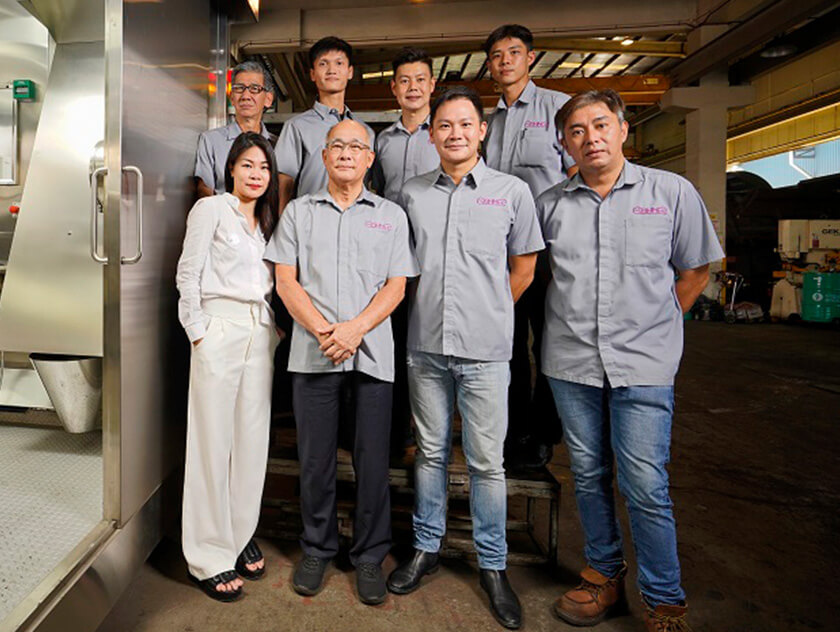The reimagined eco-district encourages companies to come together to optimise resources and close the loop by co-locating related industries such as environmental tech, agri-tech, timber and construction.
A long-time tenant in Sungei Kadut, Samwoh Corporation, is already looking forward to the synergies it could grow with its neighbours.
While Samwoh has its roots as a construction company, it recognises that there are other ways for businesses to share resources such as in the treatment of wastewater for industrial purposes. Chief Executive Officer, Mr Eric Soh, explains, “The water can be collected from anywhere, be it oil and gas, chemical, or printing companies… We have the technology to treat the water and circulate it back into the system for other uses such as planting or agriculture.”
Currently, while there are related efforts by individual companies, they are not consolidated, leading to duplicated resources and inefficiencies. “Everybody is doing recycling in their own ways. How can we sit down together and share certain areas of efforts in waste management or recycling?”
For example, companies can tap on Samwoh’s research facilities and technology for wastewater treatment to design an efficient system which helps to close the wastewater loop and reuse the treated water. Mr Soh noted that such technology is something that can be used within different clusters of industries located in the district.

Mr Soh hopes the new Sungei Kadut can be a place for more of such collaborations. He believes that the key to facilitating the sharing of resources and services is finding the common threads between various industries housed in the estate.
“Across different businesses, there are bound to be common areas we can tap… so we must understand one another’s business and bottlenecks and come up with win-win-solutions,” says Mr Soh, who adds that conversations between the different parties are crucial to building such mutual understanding.
For instance, Mr Soh imagines that Samwoh could share their transport fleet with a neighbouring company to minimise duplicating resources in the day-to-day transportation of materials.
In the same vein of conserving resources, Samwoh is constructing a new headquarters in the district that will be made entirely with recycled industrial waste, including sedimentary rocks from the Jurong Rock Caverns. Slated to be completed in 2020, the Samwoh Smart Hub will be the first positive energy industrial building in Singapore, set to produce at least 20% more energy than it consumes.
“I strongly believe that Sungei Kadut has potential as an eco-district. The Samwoh Smart Hub is an example that green can exist in Sungei Kadut, and in industrial estates.”

This focus on sustainability translates to Samwoh’s work in construction as well. “Because we build roads, a lot of people think it’s dirty, it’s smoky, there’s pollution… but we do our best to contain it and make it clean and green,” says Mr Soh. Samwoh has introduced environmentally-friendly innovations, such as by mixing recycled scrap tyres into the asphalt mix for roads.
He believes most firms see the value of being green but find it difficult to do so due to the lack of resources or knowledge. “They want to do something, but they don’t know where to start,” he says. “SMEs especially need to band together to pool their limited resources like manpower and finances”.
As such, Samwoh hopes to share their research, knowledge and technology with other companies in Sungei Kadut, to help them become greener and more sustainable.
“With the different partners co-existing in Sungei Kadut, it will be easier to share ideas and get in touch with one another.”

Building a culture of sustainability and innovation can also address hiring woes for companies, Mr Soh postulates. He discourages firms from being mired in the stereotypes of industrial work being dirty or boring. “Stop thinking this industry is not good enough to attract talent. It’s how you create the environment and opportunities, and make yourself attractive,” he says.
Besides pushing for environmental sustainability, Samwoh gives their younger employees opportunities to develop and learn, which is something they value, says Mr Soh. “Nowadays, young workers like to expose themselves to different experiences… Can we form a cluster of construction company, design house and other related companies to give them the opportunity to gain different exposure and learn skills?” This benefits industries in general too by attracting and upskilling talent, he adds.
Mr Soh is excited about the rejuvenation of the area. “If Sungei Kadut can become an environment like Shenton Way with professional opportunities for the younger generation, it can change the way industrial estates are traditionally viewed.”


